Welcome to Screen Week! Join us as we explore the films, TV shows, and video games that kept us staring at screens. More from this series
It’s boring as fuck to say that a certain year is bad, and every time someone threw their hands to the sky in the past 12 months and offered up a hearty “2017 sucks,” the world lost a hair of its capacity for reason and dialectical thinking. It’s the oldest dismissal in the book, something that’s probably been going on since year zero, and, frankly, it’s just not productive. We should all hope to aim a little clearer, a little deeper, a little further. As far as TV goes, it was a great year, because TV isn’t anchored to years — it isn’t simply a frame disconnected from the reel. Great TV is a synthesis of past, present, and future. Great TV doesn’t care if 2017 sucks; or, rather, great TV wants to understand 2017, not dismiss it.
Great shows maintain a liquid dialectic that flows from season to season, kaleidoscopic, expansive, brilliant. Great TV can show us ways of thinking and being that we don’t or can’t pursue in our everyday lives, like Legion’s insane grasp and manipulation of time and the unconscious, or Nathan For You’s willingness to follow every absurd thought to its extreme. Great TV can change the past, and great TV can create new futures. In new seasons of Twin Peaks, Mr. Robot, and Game of Thrones, we came to understand the past differently and, therefore, came to understand the tasks of the present in new ways. By the end of Twin Peaks, all the knowledge and expertise we’d supposedly amassed in the past two-plus decades had been thrown into crisis, the show’s final moments a slap in the face to those who had been so certain of its priorities.
We approached 2017’s greatest TV shows as detectives, critics, and skeptics, even when we were looking to cut loose and laugh. Highlights there were BoJack Horseman and Curb Your Enthusiasm, two great, searing shows about animals in despair. Many of this year’s shows got us to think about and to participate in the world — or at least culture — in a deeper way than we usually do, and many of us bonded with colleagues, editors, friends, and significant others over these shows, eager to share our theories and criticisms. Why don’t we apply this vigor, attention, and drive toward our own lives? Why don’t we study our own world as obsessively as we combed through Fire Walk With Me, The Secret History of Twin Peaks, and the show’s first two seasons looking for clues to unlock the mysteries of The Return? Why do we care more about the people in The Leftovers finding catharsis than we do about overcoming our own situations?
Twin Peaks may not have given you the closure you wanted, but in real life, we have the opportunity not only to understand the things that happen, but to change them. Yes, 2017 was a rough ride for most of us in one way or another, but if you didn’t learn anything about politics, art, or yourself from it other than that “it was bad,” then maybe you need to change the channel.
20
Lady Dynamite
Created by: Pam Brady & Mitch Hurwitz
[Netflix]

With the personal tragedy and ensuing nervous breakdown that occupied season one of comedian Maria Bamford’s semi-autobiographical sitcom in the rearview, we wondered how Lady Dynamite would maintain the same level of soul-baring intensity that gave its absurdism poignancy. Showrunners Pam Brady and Mitch Hurwitz pulled it off by delving deeper into Bamford’s relationships: with her partner Scott, with her increasingly estranged friends, with her controlling mother and emotionally repressed father, and even with her network (represented by the dystopian Muskvision). Season two was about familial dysfunction, how it replicates itself generation after generation and the heroic day-to-day efforts it takes to challenge it. It was about the content mines of streaming media and their place in capitalism’s blood-soaked arena. It was about a secret cabal of Hollywood feminists’ quest to awaken Ranlith the Hive Queen from her centuries of slumber. It was about so much that it distended the limits of its “bingeable fucking installments” and chipped away at the foundation of its own credibility one jarring smash-cut at a time. Like its star, Lady Dynamite was brave and life-affirming and a bit of an incoherent jumble, and for all of that, we loved it. (Oh, and were there pugs? You bet your ass there were pugs.)
19
Curb Your Enthusiasm
Created by: Larry David
[HBO]
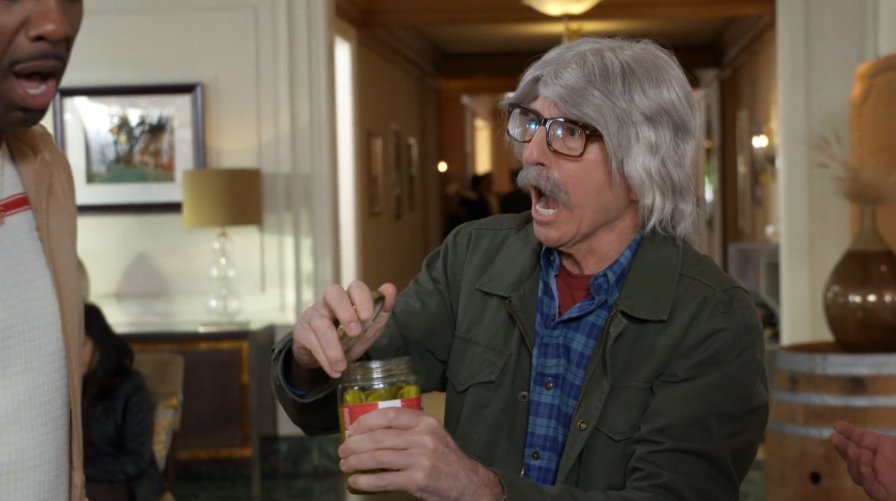
It’s become normalized for a show to “come back” and for longtime fans to become very stoked about it, wondering what the show will have to say about “now.” There’s even been social media accounts that fantasized about this, like Seinfeld 2000. Yet, unlike other shows that tepidly capitulated to the political moment of 2017 with lame caricatures or weird subplots (if you watch TV, you don’t need me to tell you which ones they are), Curb Your Enthusiasm continued to deal with the neurotic individual as particular to “now” in general, not a result of “2017” or “Trump” or whatever other bad ideologies we give ourselves for the way things are. In the new season, Larry David took aim at Hamilton, a bad employee that you don’t know how to fire, soap bottles that won’t open, accidentally taking too many painkillers, cheating on your wife, and plenty more. My favorite joke of the season was Leon’s “I’m Chappie Johnson, and I can’t open this damn pickle jar!” This season was funny, relevant, and mostly good. I’d go as far as to say it often was pretty… pretty… pretty good.
18
Master Of None
Created by: Aziz Ansari & Alan Yang
[Netflix]
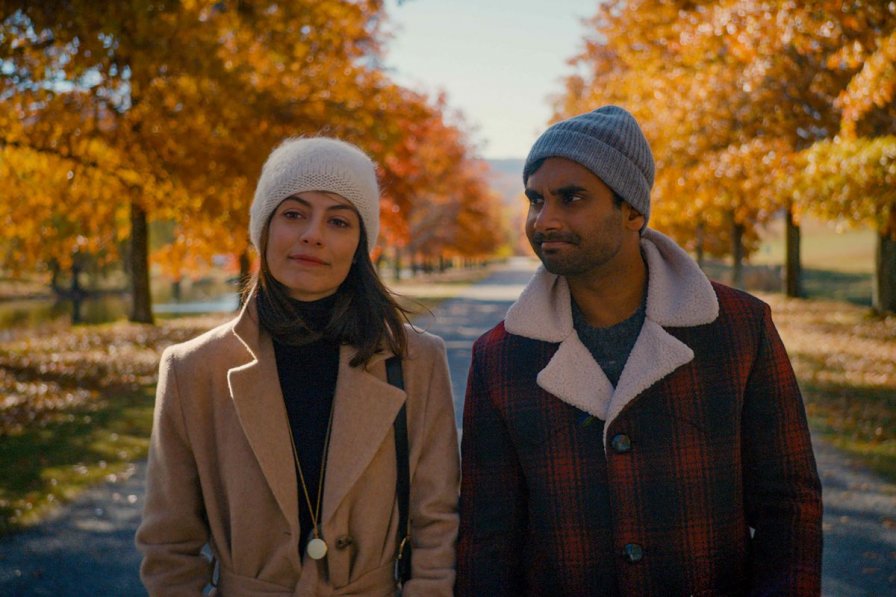
Season two of Master of None has a discernible narrative arc: something about running away from a break-up to be a pasta maker, and then learning that while the heart wants what the heart wants, sometimes your heart can really make a mess of things. At its core, though, the show remained about how the relationships we have — with family, with friends, with love interests, with whomever — impact and influence our lives. With that in mind, Master of None was able to easily thread the needle between telling affecting, relatable stories and being genuinely hilarious. This season followed Dev (series co-creator and star Aziz Ansari) through an out-and-out homage to Italian cinema (“The Thief”) and journeyed with him into the weird/harrowing/humbling world of meeting and dating people via a phone app (“First Date”). It also positioned him as a side character in a compelling, decade-spanning coming-out story (“Thanksgiving”) and set him aside entirely to explore the rich cast of characters living interesting lives in the background (“New York, I Love You”). In 2017, Master of None’s ambition saw significant increase, resulting in some of the year’s best episodes of television.
17
Stranger Things
Created by: The Duffer Brothers
[Netflix]
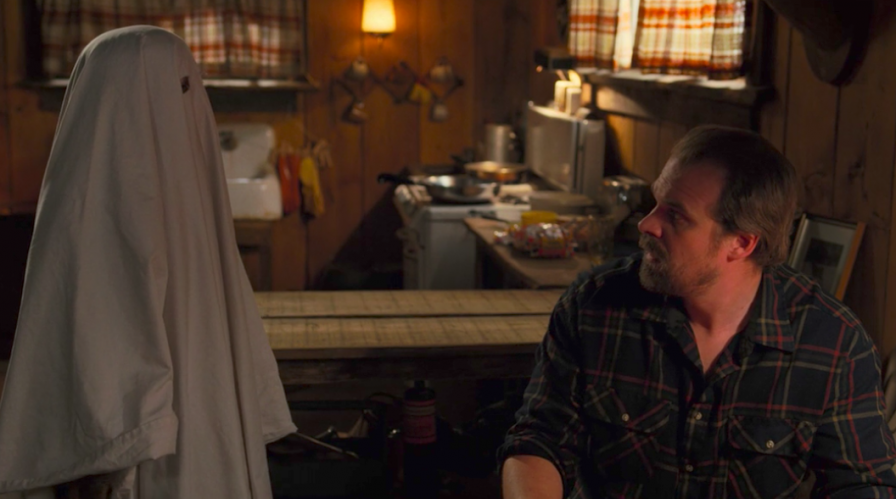
Hype is a mind flayer; it amasses its power by drawing more minds into its hive, and it thrives on a singularity of thought that, in turn, helps it seduce those of us who crave being part of something bigger. Stranger Things and its sometimes overwhelmingly nostalgic allure has always risked a swift and scathing downfall by defectors that could never see beyond Hype’s ostensibly empty promises. Between season one and two, I almost let Hype scare me away from showing up for these ordinary people with unexpectedly extraordinary stories, but against my cynical judgment, I immersed myself once again in a universe that could have been riddled with traps and instead discovered a monster even more powerful than Hype: Catharsis. Much like how Will’s own memories deteriorated as the Shadow Monster took over, Hype had made me forget why I thought Stranger Things was so totally tubular: its candor in depicting post-traumatic stress, grief, guilt, and domestic violence through children’s eyes was unmatched this year. Its final moments still fresh in my mind, I am haunted by how its campy cultural referents contextualized cyclical violence without making it more palatable for viewers whose worst memory of its temporal setting was bad hair. Stranger Things triumphed once again not because it simply continued a narrative with aesthetic fidelity, but because it faced its own Demogorgons without losing integrity, and in doing so burned Hype out of a body poised to slow dance into a firestorm for us all. Next time, for Will’s sake, I won’t let Hype drive me away.
16
Game of Thrones
Created by: David Benioff & D. B. Weiss
[HBO]
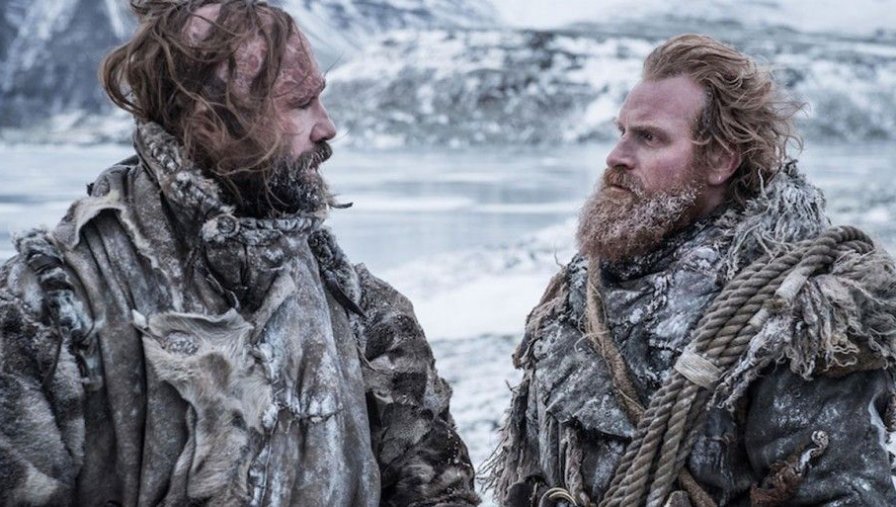
So bad it’s good is a phrase we hear all the time. Game of Thrones, out of books to use as the backbone for its storytelling, went off the rails in 2017. Sure, we fantasy lovers got more dragons and shit, fire and ice, etc., but at the cost of insanely dumb plot devices like Daenerys bringing her dragons beyond the wall on a rescue mission to see one of them turned by the Night King into what can only be described as some kind of zombie frost wyvern. Good thing for us, the Queen of Thorns had given us an incredible ending to an episode by brazenly admitting to Jaime Lannister that she was the one responsible for Joffrey’s death and that she wanted everyone to know. Also, fuck Jaime Lannister for surviving a dragon attack on his caravan in another “dumbest shit ever” moment by the use of Bronn as a deus ex machina to deliver him from death at the very last second. “I used to like this show” is a phrase I found myself revisiting during much of the season, but then I let go and realized it can be just as much fun when something you love has obvious flaws and the debate around them opens up other avenues of enjoyment. So hang on until 2019, and we’ll see if they really botch the ending. Good or bad, let’s hope for a spectacle.
15
Big Little Lies
Created by: David E. Kelley
[HBO]
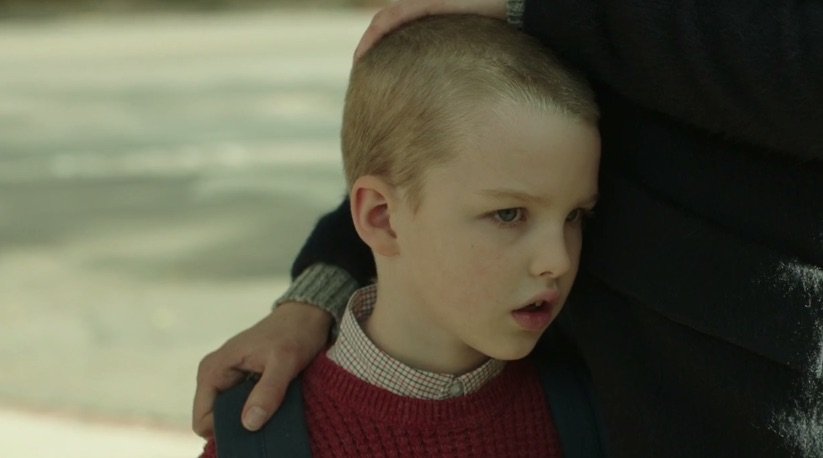
“Oh, calamity!” There’s a fear that the boundaries holding everything together could be flooded at any moment. Offscreen, 2017 had two big-little formal controversies when Twin Peaks crossed the threshold of prestige TV into film and Big Little Lies broke from the resolution of the miniseries into the instability of the serial drama. In its first incarnation, an adaptation of Liane Moriarty’s novel, the intimately funny and distressing miniseries lived for the drama (punctuated by its bougie chorus of concerned parents) and lived past the drama (survived by its righteously petty and necessarily determined heroines). The shadow of inherited trauma and cycles of violence that fell across the show’s insulated California community — padded, fuzzy, detached — turned a trivia night into a sticky drama, the night that push came to shove, when truth came out of her well. As trauma endures unfinished like the rain on the window they drown out, the promise of serialization undoes and doesn’t undo the show’s mini ending, wherein the memory of violence was wrapped neatly and profoundly in the companionship of these women (in the powerhouse performances), for themselves (the viewer, like the dreamer), in the safety of sandcastles (your scars). Nothing was washed away by the waves, and their refuge beneath darkening skies was strong enough; essential viewing.
14
Terrace House: Aloha State
Created by: John C. Ching, Julian Lai-Hung, Deborah Y. Lau, Jason K. Lau, Nicole M. Lau, Ayaka Matsumoto, Kaata Sakamoto, Yasunori Suzuki
[Fuji/Netflix]
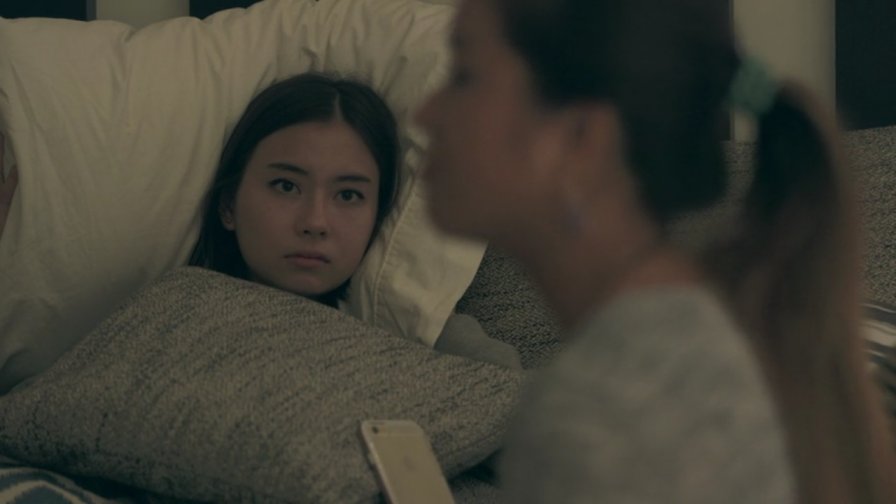
2017: a year of transcendence. In which people fled horrific social landscapes into detachment and dreams. In which mysticism soared in popularity, and in which I was moved to tears by a simple structure of driftwood on a white beach, assembled by a lovesick, jejune surfer who chewed with his mouth open. Terrace House: Aloha State was something like surreality television. Flooded with washed-out, ambient imagery and modelesque, soft-spoken young people, the show overflowed with ASMR tingles. Sharply steering away from the cliches of American reality TV — egregious editing and fabricated drama — Terrace House felt like it focused on real-life turmoil inside a dreamlike setting. Social anxiety, language barriers, service jobs, social media paranoia: these were just some of the phenomena that floated in the gentle tides between residents and their relationships. Every time the drama scenes finished and the show moved out of time, into a room of comedians guiding you through affections and criticisms of each character, it mirrored the pleasure of listening to a podcast about a show you’re simultaneously watching. It felt like having a board of friends eager to share feelings and to make you laugh over, over, and over again. Each tear shed from sad samurai Taishi Tamaki over an underwhelming goodbye, each giggle from nervous model Lauren Tsai as she struggled over language and social stress — it all composed a gorgeous, juvenile, and tender tapestry of fantastic stories. If only life could be more like Terrace House. For now, we can only dream.
13
The Vietnam War
Created by: Ken Burns & Lynn Novick
[PBS]
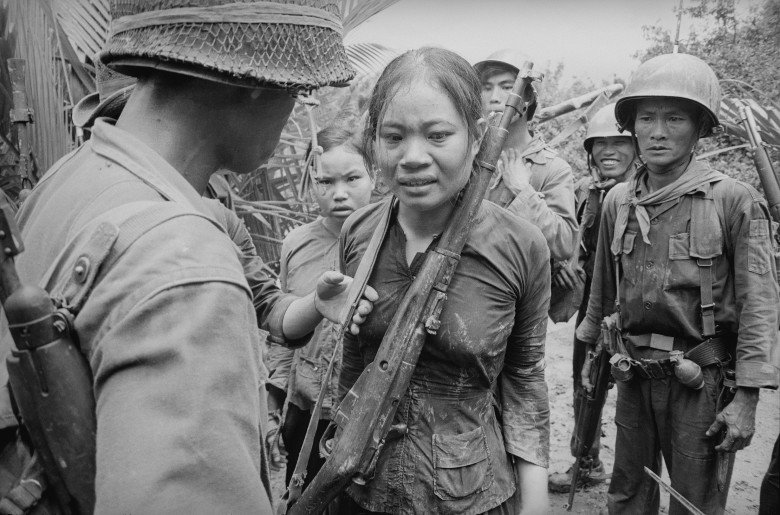
What we found most telling about Ken Burns and Lynn Novick’s latest signature gargantuan undertaking was the exceedingly vocal online disagreements among the audience about whether it was too fair to the US or not fair enough. The Americentrism at the heart of that clash was exactly what The Vietnam War would have to fight throughout its run, balancing a desire to understand how US leadership could so thoroughly falter at such intensity for such a long period of time with the larger worldwide implications of the sustained conflict it set to document. Regardless of our own internal disagreements with how well they may have handled the daunting task of such an analysis, we all nevertheless had to admit that the sheer volume and quality of archival footage and its subsequent arrangement were alone enough to merit its status as one of the most essential series of 2017. Burns and Novick have established themselves as keen observers of history, and it was absolutely fascinating to watch them give such an expansive and exhaustive treatment to events still fresh in the memories of PBS’s key demographic.
12
The Good Place
Created by: Michael Schur
[NBC]

The Good Place pulled off the incredible feat of being an incredibly sweet and hopeful show without losing any bite in its social commentary. A brilliant treatise on the philosophy of human nature, the sitcom provided a delightful look at various social and cultural mores, told in a propulsive manner that constantly revealed twists about its true story. It was like if Lost were scrambled with C.S. Lewis’s The Screwtape Letter and written by Douglas Adams. Examining life on earth through the prism of the afterlife, Schur’s delightful Good Place unfurled the power of relationships, the dynamic between good and evil, the concepts we hold dear, and those we neglect, and it did it all with excellent jokes and pitch-perfect comic timing. With top-notch performances, including Kristin Bell and a never-better Ted Danson, the show was equal parts intriguing and endearing. The Good Place offered an amazingly unique premise that enriched the soul, maintaining enough laughs to keep audiences clamoring for more.
11
Better Things
Created by: Pamela Adlon
[FX]
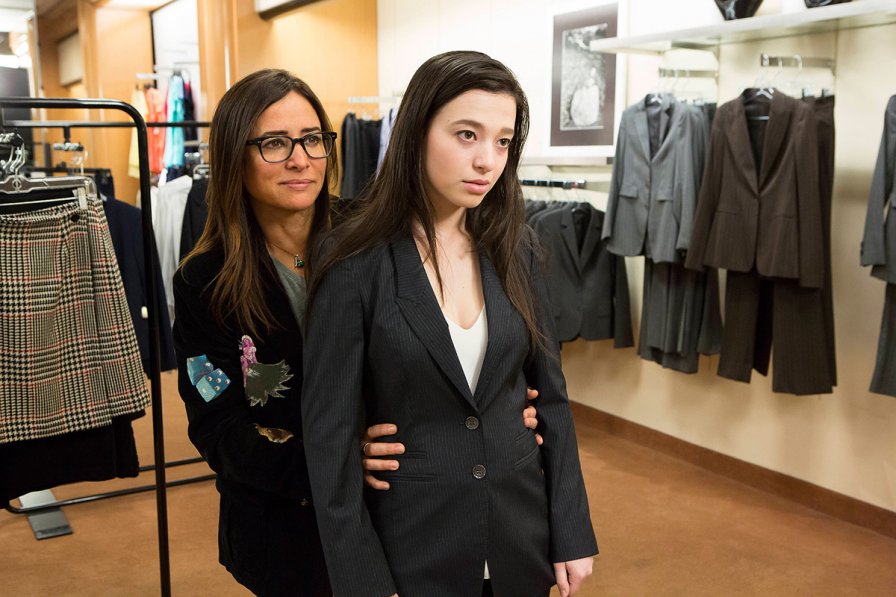
Whether it’s simple schadenfreude or reveling in the fleeting joys of counterintuitive disassociativism-as-virtue, the “dysfunctional family” tag has become as much a harbinger of roteness as the whitewashed template it was once a rebellious answer to. In this light, Better Things, and the beset matriarch at its center, felt essential as ever. Yes, Sam’s life as a single mother of three read as a messy struggle. But we saw a family that, in its own way, functioned. There was love, patience, forgiveness, and their opposites flowing in both directions. In Pamela Adlon’s Sam Fox, we again saw an adult retaining the best of childlike innocence (and, by the skin of her teeth, wonder) without giving way to idealization. As with last season, episodes blithely drifted or veered from obvious beats and denied pat resolution. Instead of a unique persona being squeezed into a proven sitcom formula, Better Things conveyed a dizzyingly sentimental, hard, vulnerable, furious, and exhausted personality of its own. And these warring traits have been so intrinsic to Adlon’s characters that, whether she finds a new writing partner or goes it alone, it seems a safe bet she’ll keep the show vital in seasons to come.
10
Halt and Catch Fire
Created by: Christopher Cantwell and Christopher C. Rogers
[AMC]

No antiheroes. Little to no sex. No (non-Nerf) guns. People staring and yelling at monitors. That this series pressed through its four seasons without ever once feeling compromised was some feat. The popular hooks of relationship conflict, cutthroat ambition, and period fetishism were nonetheless present, but Halt nimbly subverted or jumped off from them. We wanted to hate corporate Donna, but they wouldn’t let us. We loved Bos, but we got to see that love as a liability. They went steamy with Cameron and Joe early on, only to stress what set them apart later. Every song chosen was both appropriate and unobvious, perhaps exemplified by reclaiming the wistful power of this tinny waiting-room speaker dweller for a much needed post-milestone exhale. Like the equally succinct Rectify, with Mackenzie Davis being the bottleneck of emotional overwhelm that Aden Young was, this show wore its heart on its sleeve. Both felt radical in doing so, especially given the brutal realities dogging both arcs. The stakes were always high, but the intrinsic human connection (masterfully grounded by Scoot McNairy’s pragmatic, meticulous Gordon Clark) kept us in the game more than anything.
09
Nathan For You
Created by: Nathan Fielder & Michael Koman
[Comedy Central]

The fourth season of Nathan For You had an unusually long gestation period, the kind that might have caused some worry that Nathan Fielder’s team was struggling to come up with the same headline-breaking commercialist stunts the show’s first three seasons had pulled off so seamlessly. The twist, of course, is that while Fielder was still able to orchestrate such absurdities as a psychic-reading service aimed only at people named Maria Garcia or getting an L.A. City Council member to approve of his foundation for employing people with warts, the real core of Nathan For You this year was spent taking a deep, revealing dive into the show’s own internal logic. “Finding Frances,” the season’s grand finale, spent two hours following the painful odyssey of one Bill Gates impersonator’s search for his long-lost love, unearthing his twisted behaviors along the way and even questioning Fielder’s own manufactured relationships with those around him. At turns full of regret, loneliness, and some small, uneasy redemption, Nathan For You’s fourth season had us cringing in recognition more than ever before, often trading in goofy laughs for uncomfortable scrutiny and, as always, offering us sound business advice along the way.
08
Legion
Created by: Noah Hawley
[FX]

Legion — from Fargo’s Noah Hawley and based on the X-Men character of the same name — somehow eschewed all possible crossover potential most comic book media producers seem to crave these days and opted instead for a show of narrow appeal, blending subversive, non-linear storytelling, disorienting visuals, and hyperassociative blockbuster surrealism. The result was a show that interacted with a splintered version of comic book populism but didn’t owe itself to it. Instead, Legion exploded origin story convention, taking the classic superhero narrative of broken people finding a way through their individual pain and neuroses toward a place within a community that accepted them, and embellishing that psychology until it became the manic core of it all. The show combed through issues of abuse, trauma, guilt, and memory without abandoning the cartoon colors, fractured narratives, and allegorical pop wisdom of the comic book form, with all the problematic morality and reductive philosophy that implies — complicated only by an equally irreverent and hyperstylized sensibility. Legion filled many roles, but if nothing else, it was a delirious mess with more character than virtually anything else coming out of its affiliated universes.
07
Mr. Robot
Created by: Sam Esmail
[USA]

$ man whoami
“There is a part of you in me.”
$ man su
“Control is an illusion.”
$ man ethtool
“This whole time we’ve been punching ourselves in the face because of you,” says an FBI agent, later.
“There’s intel you’re not privy to that’s connected to this,” says another FBI agent, earlier.
“When I set a timeline, there’s a reason,” says whiterose, otherwise.
$ man ps
Elliot & “So much depends upon” pointless poetry & real-time Rick Deckard noir narration & principles like punch cards & chaos like, “Alexa, do you love me?” & season 3’s high stakes like Ibsen’s science fiction & what did Luke Skywalker actually find in the woods & the long black of home’s hallway & passing through the separate compartments of double lives & “she’s gonna die like everyone else” & “murder most foul, as in the best it is” & an unfixed Wonder Wheel’s trackless car & dramatic digital irony keeping you (alive) from what you don’t know (dead) & saving the revolution from yourself & re-orientation over re-volution & history favors the winners favors capital & easier to imagine the end of the world & “always gotta have a wow ending, otherwise what’s the point?” & parents fail & children will listen & sometimes ghosts kiss back & asserting identity and choosing moving forward is real time-travel & “with those two pieces you should be able to regenerate” & “we carry on” back to the future & hello friend, we’ve been here all this time & Mr. Robot
$ man kill
“There is a part of me in you.”
06
Rick And Morty
Created by: Justin Roiland & Dan Harmon
[Adult Swim]

It would be easy to dismiss Rick And Morty due to the incredibly obnoxious element of its fanbase that drives jokes into the ground or freaks out over condiments at fast food chains. But that would be doing the show a great disservice, as Roiland and Harmon produced one of the best seasons of any comedy in recent years. The Adult Swim cartoon dissected people’s capacity for cruelty and selfishness, along with their propensity for toxic behavior — a fact lost on far too many people in its audience. Rick And Morty delivered some of the best absurdist humor and imagery while utilizing well-worn sci-fi tropes, all filtered through the funhouse looking glass of a half-empty bottle of vodka. It was crude and vulgar, but also oddly touching and utterly honest in its portrayal of a multiverse gone mad through the horrible deeds of many. Yes, it got obnoxious seeing “I’m Pickle Rick, bitch!” throughout the internet, but don’t let that get in the way of one of the best half hours on television, one that was bold in vision and precise in execution.
05
The Handmaid’s Tale
Created by: Bruce Miller
[Hulu]

Just three months after Trump’s inauguration, Hulu unleashed The Handmaid’s Tale, and its rich, glorious splashes of red called out for a resistance like a signal flare in a hopelessly monochromatic world. The show’s vision of a frighteningly efficient misogynist dystopia was somehow even bleaker and more disturbing than the Reagan-era Margaret Atwood novel upon which it was based, taking on even further significance in the era of #metoo wherein women are discovering the depths of a newfound collective power to exile abusive men from positions of privilege that were, until recently, virtually untouchable. But where The Handmaid’s Tale could have simply rested on its laurels and played it safe to a crowd of woke liberals, its uneasy balancing of hope and despair actively challenged us to carefully examine the ways rebellion against authoritarianism can, and perhaps should, be constructed. Rather than leaning heavily on protestations from a soapbox, The Handmaid’s Tale grounded its sociopolitical awakening in the nightmarish experiences of Elizabeth Moss’s Offred, extending the show a sly subjectivity to play off its relentlessly soul-sucking objective reality. And like the most terrifying and impactful speculative fiction, it showed us how the seeds currently planted in our time could easily blossom into an endless hellscape we otherwise could never imagine.
04
BoJack Horseman
Created by: Raphael Bob-Waksberg
[Netflix]
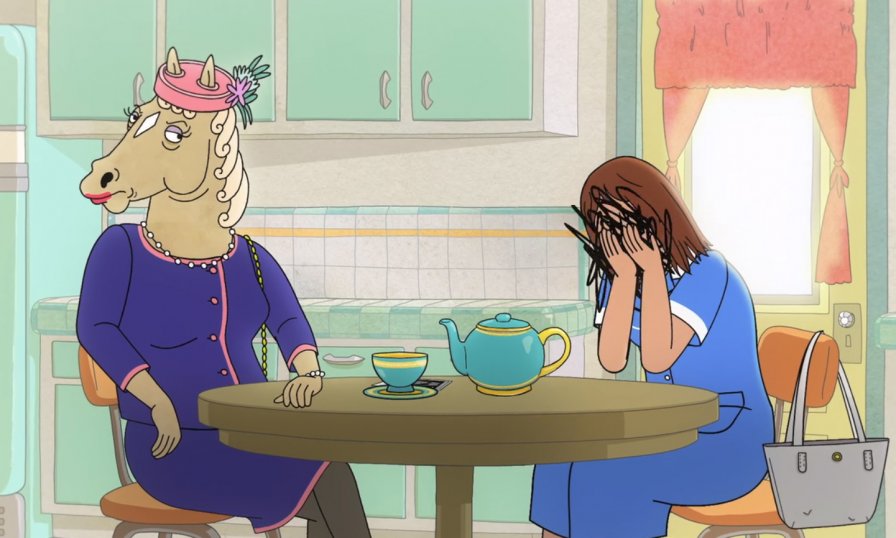
“I’ve never seen anything like this” is a dangerous phrase. Of course I’ve seen things like BoJack Horseman’s latest season; even apart from its first three remarkable seasons, its style and its tone isn’t rootless. I’ve seen witty cartoons featuring anthropomorphic animal characters (each with its own explanations of why talking animals and humans coexist), I’ve seen devastating flashback narratives haunt present desperations, I’ve seen comedies tackle alcoholism and depression and self-loathing; still, season four of BoJack Horseman seemed inimitable. What transcended its familiar elements was its deeply battered heart, which drove its tragic characters into places where we’d hoped they’d never go, even though we’ve always known deep down that downward spirals only lead one direction. For a show that revolves around cycles, it was exceptional how season four explored uncharted depths of character without deviating from its Shakespearean end game. So, without backhandedly insulting its referents and inspirations, perhaps a truer and more gratifying admonition of BoJack Horseman would be, “I’ve never felt anything like this,” evidence of a feat even greater than innovation.
03
The Leftovers
Created by: Damon Lindelof and Tom Perrotta
[HBO]

Very rarely does a TV show pull off a near-perfect masterpiece finale, but The Leftovers accomplished such a feat against many odds (not the least of which that showrunner Damon Lindelof was responsible for Lost and its hugely divisive and questionable ending). Unlike Lost, however, The Leftovers seemed to have learned from its influences (Lindelof has often cited Twin Peaks as his prime inspiration, which truly shined across the show’s surreal landscape and spiritual undertones). The third and final season doubled down on its eccentricities, stubbornly refusing to explain or provide closure to its core mystery. The Leftovers was never a mystery sci-fi about the Departure anyway (the event in which 2% of the world’s population mysteriously disappeared seven years prior to the events of the third season), but rather about grief, loss, and coping. How can we even move on — and, most importantly, where can we move on to — when our very understanding of the rules governing our world seems to have vanished along with our loved ones? Perhaps the dark subject matter and oftentimes harrowing experience turned The Leftovers away from a much-deserved broader audience, but its elegant writing, stellar performances (particularly by lead actors Carrie Coon and Justin Theroux), and a solid final season safely established its preeminent place among the elite of TV shows.
02
The Deuce
Created by: George Pelecanos & David Simon
[HBO]

With each of his succeeding series, it becomes more apparent that David Simon can legitimately do no wrong. Years ago, when Simon was laying the groundwork for The Deuce with his former The Wire collaborator George Pelecanos, he remarked how he was attempting to create the least sexy portrait of pornography imaginable. Anyone who took the time to engross themselves in the team’s latest would have to admit that they knocked it out of the park in that regard. They captured the tone, atmosphere, and somehow even the aroma of the area surrounding Times Square at its most debased. Simon has all but perfected the ability to tell stories as large as they are compelling precisely by focusing on the intimate lives of socially insignificant people. The Deuce’s first season told graceful stories of broken people in a way Simon does so unnervingly well, offering glimpses of the moral gravity of its subject matter while never once veering into the territory of simple moralism one way or the other.
01
Twin Peaks: The Return
Created by: David Lynch & Mark Frost
[Showtime]

“What is a reflection? A chance to see two? When there are chances for reflections, there can always be two — or more. Only when we are everywhere will there be just one.”
– Margaret Lanterman, The Log Lady
“Is it future, or is it past?”
– MIKE
“I’ll eat you.”
– Sarah Palmer
What do we see when we look in the mirror? What do we want to see when we look in the mirror? Reflections show us how we wear time on our face. But as we grow older, we want mirrors to show our past — to not reflect us now, but us then. What are we searching for? What can the past tell us about our present? What can our futures tell us about the past?
In 2017, Twin Peaks returned to the past after a quarter-century absence. But the series didn’t return to fetishize its legacy; it sought to rupture it. If the original run was in part a pseudo parody of soap operas that supposedly “birthed” modern television, then The Return could be understood as a meta-commentary on modern television’s sanctification and expectations of reboot culture — including the role that Twin Peaks itself plays in this nostalgia industry. Which was no small feat: the lore of Twin Peaks had more or less solidified itself through obsessive theories and analyses, but lore, of course, is infinitely malleable and always expanding. Given the show’s messy history of rotating writers and network politics, its faith in riffing on happy accidents, and the semi-divergent interests of its creators — broadly speaking, David Lynch’s spiritual, affectual dream logic in contrast to Mark Frost’s esoteric mythologies — this was especially true with Twin Peaks. But rather than simply answering the remaining questions leftover from season 2’s horrifying cliffhanger or expanding upon narratives set into motion during its original run, Lynch and Frost used the discourse of Twin Peaks lore itself as a text to play with, and it resulted in a breathtaking series that was as much a self-aware return to the franchise of Twin Peaks as Special Agent Dale Cooper’s own return to the fictional town.
The Return achieved its disarming critical nature by explicitly challenging our nostalgia and testing our patience through wild, anti-episodic experiments in duration and form. The show used time boldly, not just because the town and its characters were visibly ravaged by time, but also because the passage of time itself was such a central focus. Scenes breathed much longer than we thought possible for TV, the minimal sound design seemed adamantly opposed to smoothing over any awkwardness, and its decades-long iconography of cherry pie and coffee was decoupled in playful, humorous ways. Threads were disconnected, momentums were cut short, and the varied expressions of time reverberated through lateral plot swerves and shaggy dog stories, through time-traveling conceits and cycles of violence, through rewritten histories and fading memories — through death. “Hawk, I’m dying,” cried The Log Lady into the camera. And then she died, both as a character and in real life as Catherine E. Coulson, just days after filming.
This temporal play and subversion of nostalgia was felt most brilliantly through the “non-character” that was Cooper’s Dougie Jones. His excruciatingly prolonged, mystifying fugue state forced us to re-examine our assumptions and expectations of both the character and show, which ultimately opened our hearts to let Dougie in, mirroring his uncanny ability to wrench out the goodness of those around him. When we weren’t watching Kyle McLachlan parroting bits of dialogue and Mr. Magoo’ing his way through ridiculous scenarios as an infantile Dougie, we were watching him punch through faces and spew out creamed corn/engine oil as the ultra-violent Mr. C. Sure enough, Cooper did finally awake from his Dougie stupor, but only briefly near the end, playing a nominal role in extinguishing the series’s main threads before unveiling a deeper, more complex mystery than could’ve been imagined by even the most hardcore Twin Peaks fans. Then there was Audrey Horne, the show’s other most popular character, whose tragic predicament found expression in a Brechtian nightmare of dislocation, alienation, and detachment. Audrey’s role amounted to seemingly little plot-wise, but these scenes most incisively channeled the show’s renewed themes, offering some of its most unnerving dialogue through the curiously enclosed, circular exchanges between her (“I don’t even know who I am!”) and husband Charlie: “Now, are you going to stop playing games, or do I have to end your story too?”

But what story was there to “end”? And how could Charlie even do that? Like Kafka’s take on parables, in which he offers a parable to interrogate the usefulness of parables, one of the most intriguing elements of The Return was how it constantly pulled us out of its otherwise intense, protracted poetry to remind us of its constructed nature and the ways in which we engage with it. Whether it was Monica Belluci playing Monica Belluci, Audrey dancing to “Audrey’s Dance,” or Cooper’s superimposed face in Part 17 (“See you at the curtain call”), the hazy, dream-like composition of the show’s self-referential moments were difficult to reconcile with its sequences of concentrated realism. It didn’t help that the actual owner of the real-life Palmer house was cast as Alice Tremond or that Amanda Seyfried (Becky) had played the “Laura Palmer” victim on Veronica Mars. It didn’t help that Jim Belushi (Bradley Mitchum) had starred in Twin Peaks ripoff Wild Palms or that The Platters — whose song “My Prayer” played during two crucial scenes — had a member named David Lynch (not to mention the many, many references pointing outside the show, from Orphée to Orpheus to The Odyssey).
Taken together, these referential treatments and recycled signifiers further gestured toward the show’s artificiality and interpretive openness, carving space for us to read Twin Peaks as a mirror of and for our own reality. Its commentary on political and social decay was shown through cycles of drug addiction and domestic abuse, touching throughout on themes of mental sickness (“Hello, Johnny. How are you today?”), capitalist encroachment (Walter: “From a business perspective, the board would like you to consider some alternatives.”), wealth disparity (Dr. Amp: “The fucks are at it again!”), and atomic annihilation (Woodsman: “Gotta light?”). Even the fleeting establishing shots depicted a Twin Peaks that was foggy and polluted, its sawmill never rebuilt, with trailer park conversations about blood preservation and schoolteachers with no health insurance conjuring persistent restlessness and anxiety, wherein hysteria was treated like a disease and many of the show’s characters were physically or spiritually ill “living in a dark, dark age.”
Through this destabilizing, deconstructive backdrop and the effacement of its own lore, Lynch and Frost managed to heighten our self-awareness and critical thinking, opening our minds to a wealth of spiritual possibilities while attuning our hearts to wrenching portrayals of loss and shining examples of hope. The anachronistic, small-town feel of Twin Peaks past was here rendered as a claustrophobic anomaly, whose magical distinction wasn’t couched in the idealized goodness of its people, but in the cosmic portals that evoked grander, more complex renditions of good vs. evil. In fact, The Return complicated any simplistic dualities, introducing tulpas among its doppelgängers, adding the concept of versions to its existing reality, and exploring conflicted, paradoxical character archetypes (The Mitchum Brothers, Chantal & Hutch) who expanded the show’s empathy for humanity’s convoluted moral compass.
Consequently, we were able to dream bigger. The show’s growing lore and purposeful ambiguity encouraged us to theorize about its supposed glitches and loops (of which there were so many), to examine its emphasis on time travel and electricity/fire in the context of quantum mechanics, to frame the “dream” as a metaphor for more spiritual readings (the bardo, superimpositions, ego death, etc.), to interrogate its alternative/collapsing/colliding/multiplying timelines, to cobble together optimistic stories of pocket dreamworlds and traps in the face of its otherwise hopeless projections. There was no consensus, of course, but they all nonetheless served as clues suggesting the simple notions that nothing was quite adding up, that everything was a little off, and that ambiguity was central to any takeaway. I mean, why is there a glitched version of Ed in his reflection? What’s with the blinking plane windows? How can the diners at the Double R change seats in the middle of the scene?
But while pointing to its own artificiality provided ample space for interpretation and exposed the mundane formulas and tropes of modern television, Twin Peaks, as always, had much bigger fish to percolate. Despite hints in Fire Walk With Me and early on in The Return, its grander aims weren’t fully apparent until the final two hours of the 18-hour series, when Lynch and Frost fearlessly emptied the narrative and reduced its lore to surface-level plot through a deliciously ridiculous, hyper-contrived, fan-service ending replete with the deus ex machina that was Freddie Sykes and his green fucking glove. Then, in a genius masterstroke, they used this absurdist converging point as a springboard to offer a second ending, which suddenly widened the show’s conceptual scope and shifted tonally to an even darker, more brooding aesthetic. This served as the formal introduction to its deeper mystery — a new golden egg-laying goose to replace the one killed off by ABC executives — one that fully embodied the show’s exploration of pain and suffering and forced us to question our identification with the show’s characters and our investments in its storylines through an exquisite rug-pull that downright changed me. Watching that haunting finale was perhaps the most harrowing, crushing experience I’ve ever had with any single work of art. I could barely breathe. Suddenly, my individual taste felt irrelevant, my working theories obsolete, my attachments to its characters nullified. Everything felt undone.
Except, of course, for the originating trauma. Despite its oftentimes brilliant humor and new, lovable characters, the story of Twin Peaks ended with a reminder that pain and suffering can’t simply be forgotten or erased, that our traumas linger with us despite our prayers or revisits to the past. But the answers to our problems don’t reside in the past. Cooper, for all his heroism and best intentions, didn’t understand this when he fractured himself out of time like Phillip Jeffries and Major Briggs before him, and it was his hubris that tragically slipped away from him in the series’s final moments. Here, our white knight was reduced to a fumbling, confused lawman — neither entirely “good” nor entirely “bad” — barely able to form a question, whose priorities were skewed by his quest to find Judy, whose identity was perhaps fragmented by a reconstituted Mr. C and an orphaned Dougie tupla, whose confidence was shaken to its core by the humbling revelation that while the past dictates the future, the future also determines your past.
Ultimately, Cooper’s odyssey of remembrance worked to undo himself, not Laura Palmer’s trauma from incestuous rape and abuse, and whatever “really” happened in those final moments could neither circumvent Laura’s sustained terror nor adequately express Cooper’s quiet horror of being trapped in The Red Room for 25 years. As an audience, what we are left with isn’t closure or even a clear linear narrative, but a mirror, a reflection, a palimpsest that continually reworks itself and, therefore, continually reworks us, too.
Welcome to Screen Week! Join us as we explore the films, TV shows, and video games that kept us staring at screens. More from this series
